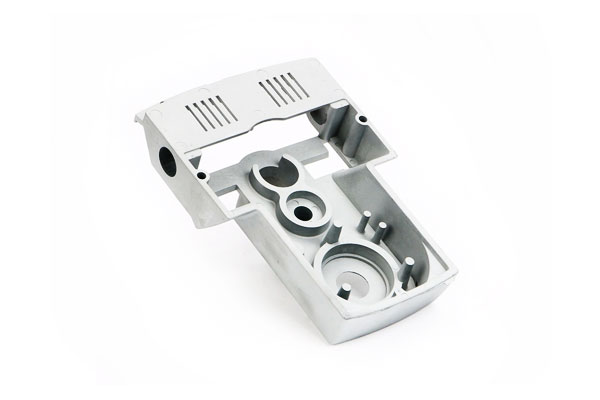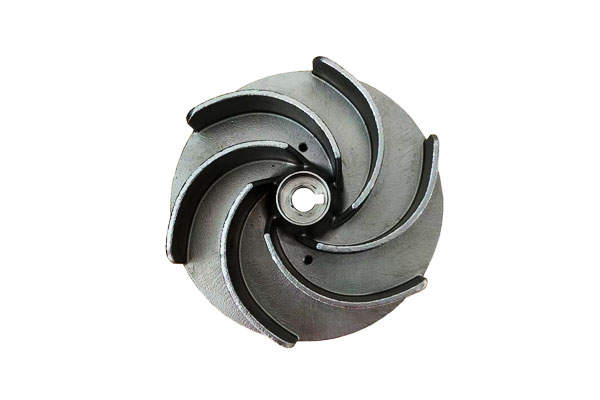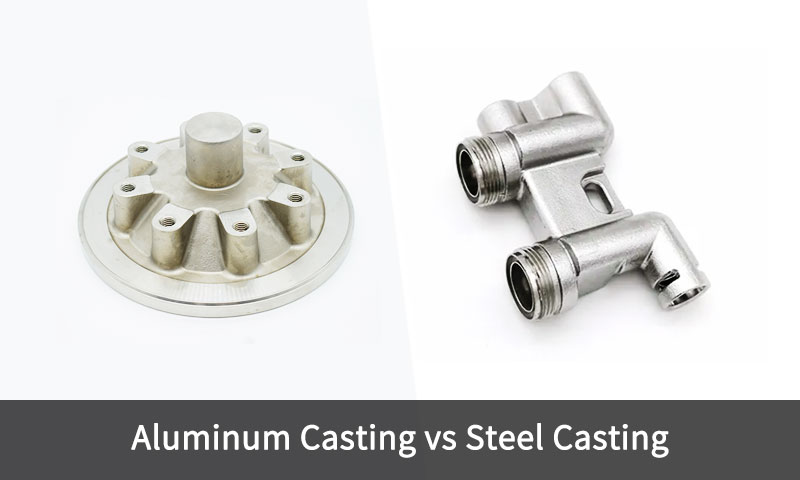1. giriiş
Alüminyum ve Çelik Döküm — bu iki temel malzeme arasında seçim yapmak bileşen performansını şekillendirir, Otomotivden enerjiye kadar birçok endüstride maliyet ve üretilebilirlik.
Bu karşılaştırma sadece metal kimyasıyla ilgili değil: yoğunluk ve sertliği kapsar, termal davranış, döküm prosesi uyumluluğu, ikincil işlem (ısıl işlem, yüzey mühendisliği), yaşam döngüsü maliyeti ve uygulamaya özel güvenilirlik.
Bu nedenle mühendisler ve satın almacılar tüm sistemi değerlendirmelidir;, sıcaklık, çevre, üretim hacmi ve son işlem gereksinimleri – metal ve döküm rotasını belirtmeden önce.
2. Alüminyum ve Çelik Arasındaki Temel Malzeme Farklılıkları
Alüminyumun özünde vs. Çelik döküm, her malzemenin döküm sırasında nasıl davrandığını doğrudan etkileyen temel bir metalurjik ve fiziksel karşıtlığa sahiptir., işleme, ve hizmet.
| Mülk | Alüminyum (Örn., Al-i alaşları) | Çelik (Örn., karbonlu veya düşük alaşımlı çelikler) | Mühendislik Çıkarları |
| Yoğunluk (g/cm³) | 2.70 | 7.85 | Alüminyum ~e daha hafiftir, Taşımacılık ve havacılıkta büyük ağırlık tasarrufu sağlıyor. |
| Erime noktası (° C) | 615–660 | 1425–1540 | Alüminyumun düşük erime noktası daha kolay döküm ve daha düşük enerji tüketimi sağlar; çelik özel fırınlar gerektirir. |
| Termal iletkenlik (W/m · k) | 120–180 | 40–60 | Alüminyum ısıyı verimli bir şekilde dağıtır; motorlar için idealdir, ısı eşanjörleri, ve elektronik. |
| Özel güç (MPA/ρ) | ~100–150 | ~70–90 | Daha düşük mutlak güce rağmen, alüminyumun mukavemet-ağırlık oranı çeliğinkini aşıyor. |
| Elastik modül (Genel not ortalaması) | 70 | 200 | Çelik daha sert, Yük ve titreşim altında daha iyi sağlamlık sağlar. |
Korozyon direnci |
Harika (Al₂O₃ katmanını oluşturur) | Değişken; kaplamalar olmadan paslanmaya eğilimli | Alüminyum oksidasyona doğal olarak direnir, çeliğin yüzey korumasına ihtiyacı varken (tablo, kaplama, veya Cr/Ni ile alaşımlama). |
| İşlenebilirlik | Harika | Orta ila zor | Alüminyumun yumuşaklığı kolay işlemeye ve daha kısa çevrim sürelerine olanak tanır; çelik daha sert takımlar gerektirir. |
| Geri dönüşüm | >90% kurtarılabilir | >90% kurtarılabilir | Her iki malzeme de oldukça geri dönüştürülebilir, alüminyumun yeniden eritilmesi daha az enerji gerektirse de (5% birincil üretim). |
| Döküm Rötresi (%) | 1.3–1.6 | 2.0–2.6 | Çelik katılaşma sırasında daha fazla büzülür, daha büyük paylar ve daha karmaşık yolluk/besleme sistemleri talep ediyor. |
| Maliyet (Yaklaşık., USD/kg) | 2.0–3.0 | 0.8–1.5 | Alüminyum kilogram başına daha pahalıdır, ancak ağırlık ve işlemedeki tasarruflar toplam yaşam döngüsü maliyetlerini dengeleyebilir. |
3. Alüminyum Döküm Nedir?
Alüminyum döküm erimiş alüminyum veya alüminyum alaşımlarının karmaşık hale getirilmesi işlemidir, kalıplar kullanan net şekle yakın bileşenler.
Dünya çapında en yaygın kullanılan metal döküm süreçlerinden biridir; 50% tüm demir dışı dökümlerin—alüminyumun mükemmel dökülebilirliği sayesinde, düşük yoğunluk, ve korozyon direnci.

Genel bakış
Alüminyum dökümde, erimiş alüminyum (tipik olarak 680–750°C) İstenilen geometride katılaşacağı bir kalıp boşluğuna dökülür veya enjekte edilir.
Alüminyumun düşük erime noktası ve yüksek akışkanlığı onu her ikisi için de ideal kılar seri üretim yöntemleri (döküm gibi) Ve Yüksek hassasiyetli uygulamalar (hassas döküm gibi).
Alüminyum Dökümün Temel Özellikleri
- Hafif ve yüksek mukavemet / ağırlık oranı:
Alüminyum dökümler mükemmel mekanik performans sunarken Çeliğin üçte biri. - İyi korozyon direnci:
İnce, kendi kendini iyileştirme alüminyum oksit tabakası (Al₂o₃) Oksidasyona ve çoğu atmosferik veya deniz korozyonuna karşı koruma sağlar. - Mükemmel termal ve elektrik iletkenliği:
Gibi uygulamalar için uygundur ısı eşanjörleri, konutlar, ve elektrikli bileşenler. - Geri dönüşüm:
Alüminyum bozulmadan süresiz olarak geri dönüştürülebilir, kadar üretim enerjisini azaltmak 95% birincil eritme ile karşılaştırıldığında.
Ortak Alüminyum Döküm Prosesleri
| Döküm yöntemi | Tanım | Tipik uygulamalar |
| Döküm | Erimiş alüminyumun çelik kalıplara yüksek basınçlı enjeksiyonu; hassas sonuçlar verir, İnce duvarlı parçalar. | Otomotiv parçaları (Dişli Konutları, parantez), Tüketici Elektroniği. |
| Kum dökümü | Erimiş metal kum kalıplara döküldü; daha büyük için uygun, düşük hacimli parçalar. | Motor blokları, manifoldlar, havacılık muhafazaları. |
| Hassas Döküm | Balmumu desenlerinden seramik kalıplar; ince detaylar ve dar toleranslar için ideal. | Havacılık türbini bileşenleri, tıbbi cihazlar. |
| Kalıcı kalıp dökümü | Yeniden kullanılabilir metal kalıplar; iyi yüzey kalitesi ve boyut kontrolü. | Pistonlar, tekerlekler, ve deniz bileşenleri. |
| Savurma döküm | Erimiş metali dağıtmak için merkezkaç kuvveti kullanır; yoğun, kusursuz yapı. | Tüpler, kollar, ve yüzükler. |
Alüminyum dökümünün avantajları
- Hafif: Bileşen ağırlığını azaltır 30–50 VS. çelik, yakıt verimliliğinin iyileştirilmesi (otomotiv) veya yük kapasitesi (havacılık).
- Enerji verimliliği: Alüminyumun erimesi gerektirir 60–p daha az enerji çelikten daha (570° C vs. 1420° C), işleme maliyetlerinin düşürülmesi 20–30.
- Korozyon direnci: Kaplama ihtiyacını ortadan kaldırır (Örn., boyamak, galvanizleme) Çoğu ortamda, bakım maliyetlerini azaltarak 40–50.
- Yüksek Hacimli Canlılık: Basınçlı döküm üretimi sağlar 1000+ makine başına parça/gün, tüketim malları talebini karşılamak.
Alüminyum Dökümün Dezavantajları
- Daha düşük mukavemet: Gerilme mukavemeti (150–400 MPa) yüksek mukavemetli çelikten P-70 daha düşüktür, ağır yük uygulamalarında kullanımın sınırlandırılması.
- Kötü Yüksek Sıcaklık Performansı: Yalnızca korur 50% oda sıcaklığı dayanımı 250°C'de, motor egzozu veya enerji santrali bileşenleri için uygunsuz hale gelir.
- Gözeneklilik riski: Döküm alüminyum gaz gözenekliliğine eğilimlidir (yüksek basınçlı enjeksiyondan), Isıl işlem seçeneklerini kısıtlamak (Örn., T6 öfkesi vakumla işlem gerektirir).
- Daha Yüksek Hammadde Maliyeti: Birincil alüminyum maliyetleri $2,500–3.500$/ton, 2Karbon çeliğinden 3 kat daha fazla.
Alüminyum Dökümün Endüstriyel Uygulamaları
Alüminyum döküm, aşağıdaki kombinasyonlardan dolayı birçok endüstride yaygın olarak kullanılmaktadır: hafif tasarım, işlenebilirlik, ve korozyon direnci:
- Otomotiv: Motor blokları, şanzıman gövdeleri, tekerlekler, ve süspansiyon kolları.
- Havacılık: Parantez, yapısal bağlantı parçaları, kompresör muhafazaları.
- Elektronik: Isı Lavaboları, Motor Konutları, muhafaza.
- Tüketici Malları: Aletler, elektrikli aletler, Mobilya Donanımı.
- Denizcilik ve Yenilenebilir Enerji: Pervaneler, konutlar, ve türbin bıçakları.
4. Çelik Döküm Nedir?
Çelik döküm karmaşık ürünler üretmek için erimiş çeliğin bir kalıba dökülmesi işlemidir, kolayca üretilemeyen veya dövülemeyen yüksek mukavemetli bileşenler.
Alüminyumun aksine, çelik var daha yüksek erime noktası (≈ 1450–1530°C) ve daha yüksek çekme mukavemeti, için ideal yapmak yük taşıma ve yüksek sıcaklık uygulamaları makine gibi, altyapı, ve enerji üretimi.

Genel bakış
Çelik dökümde, dikkatlice alaşımlanmış erimiş çelik, harcanabilir (kum, yatırım) veya kalıcı kalıplar, son parçaya yakın bir şekil halinde katılaştığı yer.
Çünkü çelik soğuduğunda önemli ölçüde büzülür, hassas sıcaklık kontrolü, geçit töreni, ve katılaşma modellemesi eleştirel.
Çelik dökümler, mekanik sağlamlık, darbe direnci, ve yapısal bütünlük, özellikle zorlu servis koşulları altında.
Çelik Dökümün Temel Özellikleri
- Olağanüstü Güç ve Dayanıklılık:
Verim güçleri çoğu zaman aşar 350 MPa, ısıl işlem görmüş alaşımlar ile 1000 MPa. - Yüksek Sıcaklık Yeteneği:
kadar mukavemeti ve oksidasyon direncini korur. 600–800°C, kompozisyona bağlı olarak. - Çok Yönlü Alaşım Seçimi:
İçerir karbon çelikler, alçak alaşım çelikler, paslanmaz çelikler, ve yüksek manganezli çelikler, her biri belirli ortamlar için uyarlanmıştır. - Kaynaklanabilirlik ve işlenebilirlik:
Dökme çelikler etkili bir şekilde sonradan işlenebilir (işlenebilir), kaynaklı, ve performansı artırmak için ısıl işleme tabi tutulmuştur.
Ortak Çelik Döküm Prosesleri
| Döküm yöntemi | Tanım | Tipik uygulamalar |
| Kum dökümü | Erimiş çelik bağlı kum kalıplara döküldü; Büyük için ideal, karmaşık parçalar. | Valf gövdeleri, pompa kasaları, makine gövdeleri. |
| Hassas Döküm | Balmumu desenlerinden oluşan seramik kalıplar; mükemmel doğruluk ve yüzey kalitesi sağlar. | Türbinli bıçaklar, cerrahi araçlar, havacılık parçaları. |
| Savurma döküm | Dönme kuvveti erimiş çeliği eşit şekilde dağıtır; yoğun silindirik bileşenler üretir. | Borular, astarlar, Yatak Yarışları. |
| Kabuk Kalıp Dökümü | İnce reçine kaplı kum kalıpları kullanır; daha yüksek hassasiyet ve daha pürüzsüz yüzeyler sağlar. | Küçük motor parçaları, parantez. |
| Sürekli döküm | Levha ve kütük gibi yarı mamul çelik ürünler için. | Haddeleme ve dövme için hammadde. |
Çelik Dökümün Avantajları
- Üstün güç & Sertlik: Gerilme mukavemeti (kadar 1500 MPa) ve etkisi tokluk (40–100J) yapısal güvenlik açısından yeri doldurulamaz hale getirin (Örn., Köprü Bileşenleri, otomotiv şasi).
- Yüksek sıcaklık performansı: Güvenilir bir şekilde çalışır 400–600 ° C (VS. alüminyumun 250°C sınırı), jet motoru gövdeleri ve enerji santrali kazanları için uygundur.
- Düşük Hammadde Maliyeti: Karbon çeliği maliyetleri $800–1200$/ton, 60–Birincil alüminyumdan p daha az.
- Direnç Giymek: Isıl işlem görmüş çelik (Örn., 4140) kadar yüzey sertliğine sahiptir 500 HB, aşındırıcı uygulamalarda değiştirme sıklığını azaltarak 50–70.
Çelik Dökümün Dezavantajları
- Yüksek Ağırlık: Yoğunluk alüminyumun 2,7 katı yakıt tüketimini artırır (otomotiv) veya yapısal yük (binalar).
- Yüksek Enerji Kullanımı: Çelik eritmek gerektirir 25–30 MWh/ton (VS. 5Alüminyum için –7 MWh/ton), işleme maliyetlerini artırarak 40–50.
- Korozyon duyarlılığı: Nemli ortamlarda karbon çeliği paslanır (korozyon oranı: 0.5–1.0 mm/yıl tuz spreyinde), kaplama gerektiren (Örn., galvanizleme) bu ekle $1.5–2,5$/kg maliyetlere.
- Zayıf İşlenebilirlik: Sertlik özel aletler gerektirir, işleme süresini artırmak 30–50 VS. alüminyum.
Çelik Dökümün Endüstriyel Uygulamaları
Çelik dökümler talepkar endüstrilere hakimdir kuvvet, dayanıklılık, ve ısı direnci:
- Yapı & Madencilik: Ekskavatör dişleri, kırıcı parçalar, bağlantıları takip et.
- Enerji & Güç üretimi: Buhar türbini muhafazaları, valf gövdeleri, nükleer bileşenler.
- Yağ & Gaz: Matkap kafaları, boru hattı vanaları, manifoldlar.
- Toplu taşıma: Tren bağlantı elemanları, Dişli Konutları, ağır hizmet motor blokları.
- Havacılık & Savunma: İniş ekipmanı, yapısal bağlantı parçaları, zırh bileşenleri.
5. Kapsamlı karşılaştırma: Alüminyum ve Çelik Döküm
Proses uyumu ve parça geometrisi
- İnce duvarlı, karmaşık, yüksek hacimli parçalar: alüminyum döküm en uygunudur (HPDC).
- Büyük, ağır, yük taşıyan parçalar: çelik/küresel grafit (Dük) kum döküm yoluyla demir ve dökme çelikler tercih edilir.
- Yüksek bütünlük gereksinimleri olan orta hacimli: mukavemet ihtiyaçlarına bağlı olarak düşük basınçlı alüminyum veya hassas döküm çelikleri.
Mekanik performans & işleme sonrası
- Isıl işlem: dökme çelik söndürülebilir & yüksek mukavemet ve tokluk elde etmek için temperlenmiş; alüminyum alaşımlarının yaşlandırma sertleşme yolları vardır ancak daha düşük maksimum dayanımlara ulaşırlar.
- Yüzey mühendisliği: alüminyum kolayca anotlanır; çelik nitrürlenebilir, karbürlenmiş, indüksiyonla sertleştirilmiş veya sert maddelerle kaplanmış (seramik, sert krom).
Maliyet sürücüleri (tipik hususlar)
- Kg başına malzeme maliyeti: alüminyum ham metalin kg başına fiyatı, demir hurdasına/çeliğe göre daha yüksek olma eğilimindedir, ancak parça kütlesi gerekli miktarı azaltır.
- Alet: basınçlı döküm kalıpları pahalıdır (yüksek başlangıç amortismanı) ancak hacimlerde parça başına düşük maliyet >10k–100k; kum işleme ucuzdur ancak parça başına işçilik daha yüksektir.
- İşleme: alüminyum makineleri daha hızlı (daha yüksek kaldırma oranları), alt takım aşınması; çelik daha sert takımlar ve daha fazla işleme süresi gerektirir; özellikle küçük partiler için toplam maliyeti artırır.
Üretim & kusur modları
- Gözeneklilik: HPDC alüminyum gaz ve büzülme gözenekliliği geliştirebilir; kalıcı kalıp ve düşük basınç gözenekliliği azaltır.
Çelik dökümler kalıntılara ve ayrışmaya maruz kalabilir; kontrollü erime ve HT sonrası kusurları azaltır. - Boyutsal kontrol: döküm alüminyum sıkı toleranslara ulaşır (± 0.1-0.3 mm); kum döküm çeliği toleransları daha gevşektir (±0,5–2 mm) işleme sonrası.
Çevre & yaşam döngüsü
- Geri dönüşüm: her iki metal de oldukça geri dönüştürülebilirdir. Geri dönüştürülmüş alüminyum küçük bir kısım kullanır (~%5–10) birincil eritme enerjisinin; geri dönüştürülmüş çelik aynı zamanda işlenmemiş demire kıyasla büyük enerji tasarrufu sağlar.
- Kullanım aşaması: hafif alüminyum araçlardaki yakıt tüketimini azaltabilir; sistem düzeyinde çevresel bir fayda.
Masa: Alüminyum ve Çelik Döküm - Temel Teknik Karşılaştırma
| Kategori | Alüminyum döküm | Çelik Döküm |
| Yoğunluk (g/cm³) | ~2.70 | ~7.80 |
| Erime noktası (° C / ° f) | 660° C / 1220° f | 1450–1530°C / 2640–2790°F |
| Kuvvet (Gerilme / Teslim olmak, MPa) | 130–350 / 70–250 (asi); kadar 500 Isı işlemden sonra | 400–1200 / 250–1000 (Sınıf ve ısı işlemesine bağlı olarak) |
| Sertlik (HB) | 30–120 | 120–400 |
| Elastik modül (Genel not ortalaması) | 70 | 200 |
| Termal iletkenlik (W/m · k) | 150–230 | 25–60 |
| Elektriksel iletkenlik (% IACS) | 35–60 | 3–10 |
| Korozyon direnci | Harika (doğal oksit tabakası) | Değişken – alaşımlama gerektirir (CR, İçinde, Mo) veya kaplama |
| Oksidasyon direnci (Yüksek Sıcaklık) | Sınırlı (<250° C) | İyi ila mükemmel (Bazı alaşımlar için 800°C'ye kadar) |
| İşlenebilirlik | Harika (yumuşak, kesilmesi kolay) | Orta ila fakir (Daha güçlü, aşındırıcı) |
| Bozulabilirlik (Akışkanlık & Büzülme) | Yüksek akışkanlık, düşük büzülme | Daha düşük akışkanlık, daha yüksek büzülme – hassas yolluk gerektirir |
| Ağırlık avantajı | ~e çelikten daha hafif | Ağır – yapısal yükler için uygun |
Yüzey İşlemi |
Düz, iyi detay üretimi | Daha pürüzlü yüzeyler; işleme veya kumlama gerektirebilir |
| Isıl İşlem Esnekliği | Harika (T6, T7 öfkesi) | Geniş (tavlama, söndürme, temkinli, normalleştirme) |
| Geri dönüşüm | >90% verimli bir şekilde geri dönüştürüldü | >90% geri dönüştürülebilir ancak daha yüksek yeniden eritme enerjisi gerektirir |
| Üretim Maliyeti | Daha düşük enerji, Daha hızlı döngü süreleri | Daha yüksek eritme maliyeti ve takım aşınması |
| Tipik toleranslar (mm) | ±0,25 ila ±0,5 (Die Döküm); ±1,0 (kum dökümü) | ±0,5–1,5 prosese bağlı olarak |
| Çevresel Ayak İzi | Düşük (özellikle geri dönüştürülmüş alüminyum) | Yüksek erime noktası nedeniyle daha yüksek CO₂ ve enerji ayak izi |
| Tipik uygulamalar | Otomotiv tekerlekleri, konutlar, havacılık parçaları, Tüketici Malları | Vanalar, türbinler, ağır makineler, yapısal bileşenler |
6. Çözüm
Alüminyum ve çelik dökümler farklı mühendislik problemlerini çözer.
Alüminyum burada öne çıkıyor hafif, termal iletkenlik, yüzey kalitesi ve yüksek üretim oranları konu.
Çelik (ve dökme demirler) nereye hakim olmak yüksek güç, sertlik, Direnç Giymek, dayanıklılık ve yüksek sıcaklık performansı gerekli.
İyi malzeme seçimi dengeleri fonksiyonel gereksinimler, maliyet (toplam yaşam döngüsü), üretilebilirlik ve bitirme.
Birçok modern tasarımda hibrit çözümler ortaya çıkıyor (alüminyum dökümlerde çelik uçlar, kaplamalı veya bimetalik bileşenler) her iki metalin güçlü yönlerinden yararlanmak.
SSS
Hangisi daha güçlü: dökme alüminyum veya dökme çelik?
Dökme çelik önemli ölçüde daha güçlüdür; A216 WCB çeliğinin çekme dayanımı 485 MPa, 67% A356-T6 alüminyumdan daha yüksek (290 MPa).
Çelik ayrıca çok daha fazla tokluğa ve aşınma direncine sahiptir.
Dökme alüminyum, dökme çeliğin yerini alabilir?
Yalnızca mukavemetten ziyade ağırlığın azaltılmasına öncelik verilen uygulamalarda (Örn., otomotiv yapısal olmayan parçaları).
Yüksek yük için çeliğin yeri doldurulamaz, yüksek sıcaklık bileşenleri (Örn., türbin kasaları).
Hangisi korozyona daha dayanıklıdır: dökme alüminyum veya dökme çelik?
Dökme alüminyum çoğu ortamda korozyona daha dayanıklıdır (korozyon oranı <0.1 mm/yıl) VS. karbon çeliği (0.5–1.0 mm/yıl).
Paslanmaz çelik dökümler alüminyumun korozyon direncine uygundur ancak maliyeti 2-3 kat daha fazladır.
Alüminyum için hangi döküm işlemi en iyisidir?. çelik?
Alüminyum basınçlı döküm için idealdir (yüksek hacimli) ve kum dökümü (düşük maliyetli).
Çelik kum dökümü için en iyisidir (büyük parçalar) ve yatırım dökümü (karmaşık, yüksek toleranslı bileşenler). Çelik için basınçlı döküm nadiren kullanılır.


